The fully automatic blood cell analyzer market is expected to grow from USD 1.1 billion in 2025 to USD 1.9 billion by 2035, supported by laboratory modernization and expanding diagnostic workloads. One key opportunity lies in migrating from manual and semi-automatic hematology testing to fully automated multi-parameter platforms in secondary and district-level healthcare systems. As hospitals move to reduce technician dependency and improve test repeatability, suppliers offering scalable analyzers with simplified workflow integration stand to gain. The rising burden of chronic diseases, oncology monitoring, and routine health screening programs is driving sustained test volume growth, opening opportunities for analyzers with faster turnaround times, lower reagent consumption, and remote calibration support. Additionally, manufacturers providing cloud-connected reporting dashboards and interoperability with standard laboratory information systems can differentiate strongly in institutional procurement cycles.
Another major opportunity arises in compact, point-of-care-compatible analyzers suitable for physician clinics, mobile diagnostic vans, and decentralized care units. These systems enable standardized hematology testing closer to the patient, supporting faster triage and reducing central lab load. Furthermore, suppliers that offer reagent standardization programs, predictable cost-per-test models, and long-term service contracts can improve customer retention in competitive tenders. Geography-wise, rising healthcare infrastructure investment across South Asia, Africa, and Latin America creates strong entry potential for mid-range, durable analyzer systems tailored for high-usage environments.
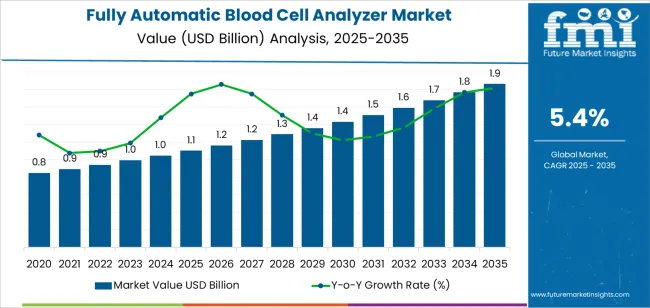
The latter half (2030-2035) will witness sustained growth from USD 1.4 billion to USD 1.9 billion, representing an addition of USD 437.8 million or 56.6% of the decade's expansion. This period will be defined by mass market penetration of specialized analyzer designs, integration with comprehensive laboratory information management platforms, and seamless compatibility with existing diagnostic infrastructure. The market trajectory signals fundamental shifts in how healthcare providers approach laboratory automation optimization and diagnostic quality management, with participants positioned to benefit from sustained demand across multiple analysis methods and application segments.
The Fully Automatic Blood Cell Analyzer market demonstrates distinct growth phases with varying market characteristics and competitive dynamics. Between 2025 and 2030, the market progresses through its technology adoption phase, expanding from USD 1.1 billion to USD 1.4 billion with steady annual increments averaging 5.4% growth. This period showcases the transition from basic hematology testing formulations to advanced impedance method systems with enhanced diagnostic capabilities and integrated quality control systems becoming mainstream features.
The 2025-2030 phase adds USD 336.6 million to market value, representing 43.4% of total decade expansion. Market maturation factors include standardization of clinical laboratory and diagnostic protocols, declining component costs for specialized analyzer formulations, and increasing healthcare awareness of automated testing benefits reaching optimal diagnostic effectiveness in hospital and clinical applications. Competitive landscape evolution during this period features established diagnostic manufacturers like Beckman Coulter and Sysmex Corporation expanding their analyzer portfolios while specialty manufacturers focus on advanced technology development and enhanced analytical capabilities.
From 2030 to 2035, market dynamics shift toward advanced analytical integration and global healthcare expansion, with growth continuing from USD 1.4 billion to USD 1.9 billion, adding USD 437.8 million or 56.6% of total expansion. This phase transition centers on specialized analysis method systems, integration with automated laboratory networks, and deployment across diverse hospital and clinical scenarios, becoming standard rather than specialized applications. The competitive environment matures with focus shifting from basic diagnostic capability to comprehensive laboratory optimization systems and integration with healthcare monitoring platforms.
| Metric | Value |
|---|---|
| Market Value (2025) | USD 1.1 billion |
| Market Forecast (2035) | USD 1.9 billion |
| Growth Rate | 5.4% CAGR |
| Leading Technology | Impedance Method Analysis Method |
| Primary Application | Hospitals Application Segment |
The market demonstrates strong fundamentals with impedance method systems capturing a dominant share through advanced diagnostic accuracy and analytical optimization capabilities. Hospital applications drive primary demand, supported by increasing laboratory automation and diagnostic technology requirements. Geographic expansion remains concentrated in developed markets with established healthcare infrastructure, while emerging economies show accelerating adoption rates driven by hospital modernization expansion and rising diagnostic standards.
Market expansion rests on three fundamental shifts driving adoption across the hospital, clinical, and diagnostic sectors. First, laboratory automation demand creates compelling operational advantages through fully automatic blood cell analyzers that provide immediate diagnostic accuracy and workflow optimization without compromising testing quality, enabling healthcare facilities to meet stringent accuracy standards while maintaining laboratory productivity and reducing manual processing time. Second, healthcare infrastructure modernization accelerates as hospitals worldwide seek advanced analyzer systems that complement traditional diagnostic processes, enabling precise hematology testing and quality control that align with medical standards and regulatory requirements.
Third, diagnostic accuracy enhancement drives adoption from hospital laboratories and clinical testing facilities requiring effective analytical solutions that maximize testing precision while maintaining operational productivity during sample processing and result generation operations. Growth faces headwinds from equipment cost challenges that vary across analyzer suppliers regarding the pricing of advanced diagnostic systems and specialty components, which may limit adoption in cost-sensitive environments. Technical limitations also persist regarding sample handling requirements and calibration maintenance that may reduce effectiveness in high-volume testing and diverse specimen scenarios, which affect diagnostic performance and operational requirements.
The fully automatic blood cell analyzer market represents a specialized yet critical diagnostic opportunity driven by expanding global hospital laboratory capacity, healthcare infrastructure modernization, and the need for superior diagnostic accuracy in diverse clinical applications. As healthcare providers worldwide seek to achieve optimal testing precision, reduce turnaround time, and integrate advanced analyzer systems with automated platforms, fully automatic blood cell analyzers are evolving from basic counting instruments to sophisticated diagnostic solutions ensuring clinical accuracy and laboratory efficiency leadership.
The market's growth trajectory from USD 1.1 billion in 2025 to USD 1.9 billion by 2035 at a 5.4% CAGR reflects fundamental shifts in healthcare diagnostic requirements and laboratory automation optimization. Geographic expansion opportunities are particularly pronounced in Asia Pacific markets, while the dominance of impedance method systems and hospital applications provides clear strategic focus areas.
Strengthening the dominant impedance method segment through enhanced analytical accuracy, superior testing reliability, and automated processing systems. This pathway focuses on optimizing measurement precision, improving diagnostic consistency, extending operational effectiveness to optimal accuracy rates, and developing specialized formulations for diverse applications. Market leadership consolidation through advanced technology engineering and automated laboratory integration enables premium positioning while defending competitive advantages against alternative methods. Expected revenue pool: USD 180-240 million
Rapid hospital laboratory and diagnostic infrastructure growth across Asia Pacific creates substantial expansion opportunities through local production capabilities and technology transfer partnerships. Growing healthcare investment and government modernization initiatives drive sustained demand for advanced analyzer systems. Localization strategies reduce import costs, enable faster technical support, and position companies advantageously for procurement programs while accessing growing domestic markets. Expected revenue pool: USD 155-205 million
Expansion within the dominant hospital segment (estimated 60% market share) through specialized analyzer designs addressing clinical laboratory standards and high-volume testing requirements. This pathway encompasses automated workflow systems, quality control integration, and compatibility with diverse laboratory processes. Premium positioning reflects superior diagnostic accuracy and comprehensive regulatory compliance supporting modern hospital operations. Expected revenue pool: USD 135-180 million
Strategic expansion into clinical applications (estimated 40% market share) requires enhanced analytical capabilities and specialized analyzer formulations addressing outpatient diagnostic operational requirements. This pathway addresses point-of-care testing, rapid result generation, and compact analyzer designs with advanced technology for demanding clinical standards. Premium pricing reflects specialized application requirements and extended reliability standards. Expected revenue pool: USD 105-145 million
Expansion of fluorescence method segment (estimated 35% market share) through enhanced detection sensitivity, premium analytical accuracy, and specialized advanced testing requirements. This pathway encompasses high-complexity laboratory applications, research diagnostic products, and specialty formulations requiring superior analytical characteristics. Market development through advanced optical engineering enables differentiated positioning while accessing premium markets requiring highest-precision diagnostic solutions. Expected revenue pool: USD 90-125 million
Development of specialized chemical staining method formulations (estimated 10% market share) addressing specific diagnostic requirements and niche laboratory demands. This pathway encompasses morphology analysis, specialized cell differentiation, and cost-effective alternatives for comprehensive hematology applications. Technology differentiation through proprietary staining protocols enables diversified revenue streams while reducing dependency on single method platforms. Expected revenue pool: USD 65-90 million
Development of regulatory-compliant analyzer formulations addressing certification requirements and quality standards across hospital and clinical applications. This pathway encompasses FDA approval, CE marking, and comprehensive quality documentation. Premium positioning reflects regulatory leadership and quality assurance expertise while enabling access to regulated procurement programs and compliance-driven healthcare partnerships. Expected revenue pool: USD 55-75 million
Primary Classification: The market segments by analysis method into Impedance Method, Fluorescence Method, and Chemical Staining Method categories, representing the evolution from basic counting technologies to specialized analyzer solutions for comprehensive hematology optimization.
Secondary Classification: Application segmentation divides the market into Hospitals and Clinics sectors, reflecting distinct requirements for testing capacity, diagnostic speed, and analytical accuracy standards.
Regional Classification: Geographic distribution covers Asia Pacific, Europe, North America, and other regions, with developed markets leading adoption while emerging economies show accelerating growth patterns driven by healthcare modernization programs.
The segmentation structure reveals technology progression from standard impedance-based formulations toward specialized analytical systems with enhanced diagnostic and accuracy capabilities, while application diversity spans from hospital laboratory testing to specialized clinical diagnostic applications requiring precise analyzer solutions.
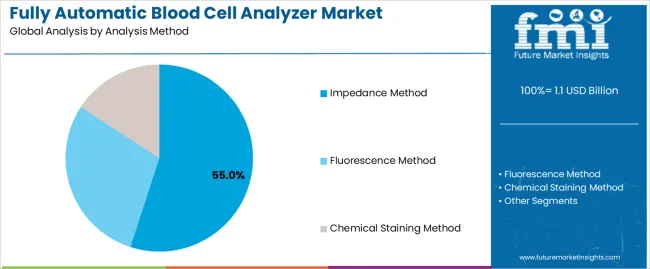
Market Position: Impedance method systems command the leading position in the Fully Automatic Blood Cell Analyzer market with approximately 55% market share through advanced measurement technology, including superior counting accuracy, cost-effective operation capability, and processing optimization that enable laboratories to achieve optimal diagnostic performance across diverse hospital and clinical environments.
Value Drivers: The segment benefits from laboratory preference for reliable analyzer systems that provide consistent testing results, reduced operational complexity, and workflow efficiency without requiring significant infrastructure modifications. Advanced analytical features enable automated sample processing, result consistency, and integration with existing laboratory equipment, where measurement reliability and processing speed represent critical operational requirements.
Competitive Advantages: Impedance method systems differentiate through proven measurement accuracy, consistent analytical performance, and integration with automated laboratory systems that enhance operational effectiveness while maintaining optimal quality suitable for diverse hospital diagnostic applications.
Key market characteristics:
Fluorescence method systems maintain premium analytical positioning in the Fully Automatic Blood Cell Analyzer market due to their enhanced detection properties and advanced diagnostic advantages. These systems appeal to laboratories requiring sophisticated measurement capabilities with superior sensitivity for specialized hematology testing applications. Market adoption is driven by research laboratory expansion, emphasizing high-precision diagnostic solutions and analytical excellence through optimized fluorescence detection systems while maintaining comprehensive testing capabilities.
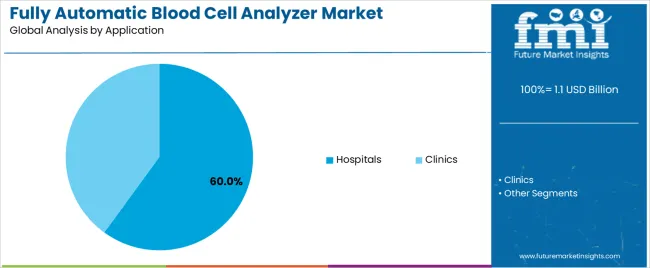
Market Context: Hospital applications dominate the Fully Automatic Blood Cell Analyzer market with approximately 60% market share due to widespread adoption of automated diagnostic systems and increasing focus on laboratory efficiency, workflow optimization, and quality management applications that minimize testing errors while maintaining healthcare standards.
Appeal Factors: Hospital laboratories prioritize testing reliability, analytical consistency, and integration with existing diagnostic infrastructure that enables coordinated analyzer deployment across multiple testing departments. The segment benefits from substantial healthcare investment and modernization programs that emphasize the acquisition of automated analyzers for quality control and diagnostic accuracy applications.
Growth Drivers: Hospital laboratory expansion programs incorporate fully automatic blood cell analyzers as standard equipment for clinical diagnostic operations, while emergency department growth increases demand for rapid testing capabilities that comply with medical standards and minimize patient turnaround time.
Market Challenges: Varying healthcare standards and laboratory protocol differences may limit analyzer standardization across different hospital facilities or operational scenarios.
Application dynamics include:
Clinic applications capture approximately 40% market share through specialized testing requirements in outpatient diagnostic facilities, primary care laboratories, and point-of-care testing applications. These facilities demand compact analyzer systems capable of delivering accurate results while providing efficient workflow and user-friendly operational capabilities.
Growth Accelerators: Hospital laboratory modernization drives primary adoption as fully automatic blood cell analyzers provide superior diagnostic accuracy capabilities that enable healthcare facilities to meet stringent quality standards without excessive equipment costs, supporting clinical operations and laboratory missions that require precise hematology testing applications. Healthcare infrastructure investment demand accelerates market expansion as hospitals seek effective automated systems that minimize manual processing while maintaining operational effectiveness during high-volume testing and emergency diagnostic scenarios. Healthcare spending increases worldwide, creating sustained demand for advanced analyzer systems that complement traditional laboratory processes and provide diagnostic excellence in competitive healthcare markets.
Growth Inhibitors: Equipment cost challenges vary across analyzer suppliers regarding the pricing of advanced diagnostic systems and specialty components, which may limit operational flexibility and market penetration in regions with constrained healthcare budgets or cost-sensitive laboratory operations. Technical performance limitations persist regarding sample preparation requirements and maintenance complexity that may reduce effectiveness in resource-limited settings, small laboratory environments, or facilities with limited technical expertise, affecting diagnostic reliability and operational requirements. Market fragmentation across multiple healthcare standards and laboratory protocols creates compatibility concerns between different analyzer suppliers and existing diagnostic infrastructure.
Market Evolution Patterns: Adoption accelerates in tertiary care hospitals and reference laboratory sectors where diagnostic precision justifies analyzer investment costs, with geographic concentration in developed markets transitioning toward mainstream adoption in emerging economies driven by healthcare infrastructure expansion and quality awareness. Technology development focuses on enhanced analytical accuracy, improved automation integration, and compatibility with laboratory information systems that optimize diagnostic performance and workflow effectiveness. The market could face disruption if alternative point-of-care technologies or simplified testing innovations significantly limit the deployment of fully automatic analyzers in clinical applications, though automated systems' unique combination of high throughput, analytical precision, and comprehensive testing continues to make them preferred in hospital laboratory applications.
The Fully Automatic Blood Cell Analyzer market demonstrates varied regional dynamics with Growth Leaders including China (7.2% CAGR) and India (6.7% CAGR) driving expansion through hospital laboratory capacity additions and healthcare modernization programs. Steady Performers encompass Germany (6.2% CAGR), Brazil (5.6% CAGR), and United States (5.1% CAGR), benefiting from established healthcare industries and advanced diagnostic adoption. Mature Markets feature United Kingdom (4.5% CAGR) and Japan (4% CAGR), where specialized hospital laboratory applications and quality diagnostic integration support consistent growth patterns.

| Country | CAGR (2025-2035) |
|---|---|
| China | 7.2% |
| India | 6.7% |
| Germany | 6.2% |
| Brazil | 5.6% |
| United States | 5.1% |
| United Kingdom | 4.5% |
| Japan | 4% |
Regional synthesis reveals Asia Pacific markets leading adoption through hospital laboratory expansion and healthcare infrastructure development, while European countries maintain steady expansion supported by diagnostic technology advancement and regulatory standardization requirements. North American markets show moderate growth driven by laboratory automation applications and healthcare quality integration trends.

The Chinese market emphasizes advanced diagnostic features, including precision measurement control and integration with comprehensive laboratory information platforms that manage testing quality, workflow optimization, and diagnostic applications through unified monitoring systems. The country demonstrates strong growth at 7.2% CAGR, driven by hospital modernization, healthcare infrastructure initiatives, and emerging diagnostic technology development that support analyzer integration. Chinese healthcare facilities prioritize operational effectiveness with fully automatic blood cell analyzers delivering consistent diagnostic performance through advanced analytical capabilities and system adaptation features.
Technology deployment channels include major hospital laboratories, specialized diagnostic manufacturers, and healthcare procurement programs that support professional applications for complex hematology testing and clinical diagnostic applications. Laboratory platform integration capabilities with established healthcare systems expand market appeal across diverse operational requirements seeking analytical precision and efficiency benefits. The expanding middle-class population and accelerating healthcare market create sustained demand, while innovative applications in point-of-care diagnostics and telemedicine open new growth avenues.
Performance Metrics:
Germany's advanced healthcare market demonstrates sophisticated analyzer deployment with documented operational effectiveness in hospital laboratory applications and clinical diagnostic facilities through integration with existing diagnostic systems and laboratory infrastructure. The country leverages engineering expertise in medical device technology and laboratory systems integration to maintain strong growth at 6.2% CAGR. Industrial centers, including Frankfurt, Munich, and Hamburg, showcase premium installations where analyzer systems integrate with comprehensive laboratory platforms and quality management systems to optimize diagnostic operations and testing effectiveness.
German healthcare providers prioritize system reliability and regulatory compliance in analyzer development, creating demand for certified diagnostic systems with advanced features, including automated quality control and laboratory information system integration. The market benefits from established hospital infrastructure and commitment to invest in advanced diagnostic technologies that provide long-term clinical benefits and compliance with EU medical device and quality standards.
Market Intelligence Brief:
The USA fully automatic blood cell analyzer market demonstrates sophisticated deployment across hospital laboratory applications with documented effectiveness in clinical diagnostic testing and emergency department facilities through integration with comprehensive laboratory information management systems and regulatory compliance infrastructure. The country leverages advanced healthcare capabilities in diagnostic innovation and quality assurance technologies to maintain moderate growth at 5.1% CAGR. Healthcare centers, including New York, Chicago, and Los Angeles, showcase premium installations where analyzer systems integrate with comprehensive diagnostic platforms and electronic health record networks to optimize testing accuracy and workflow effectiveness.
American healthcare providers prioritize diagnostic reliability and regulatory compliance in analyzer development, creating demand for FDA-approved systems with advanced features, including automated calibration and quality control integration. The market benefits from established hospital infrastructure and willingness to invest in advanced diagnostic technologies that provide long-term clinical benefits and compliance with CLIA and FDA standards.
Market Intelligence Brief:
The UK fully automatic blood cell analyzer market demonstrates advanced quality deployment with documented operational effectiveness in hospital laboratory applications and clinical diagnostic facilities through integration with existing NHS systems and regulatory infrastructure. The country leverages healthcare expertise in diagnostic quality and laboratory systems integration to maintain steady growth at 4.5% CAGR. Healthcare centers, including London, Manchester, and Birmingham, showcase quality installations where analyzer systems integrate with comprehensive laboratory platforms and healthcare management systems to optimize diagnostic compliance and testing effectiveness.
British healthcare providers prioritize system reliability and regulatory compliance in analyzer development, creating demand for certified diagnostic systems with advanced features, including automated quality monitoring and electronic result reporting. The market benefits from established NHS infrastructure and commitment to invest in quality diagnostic technologies that provide long-term clinical benefits and compliance with UK and EU medical device standards. Hospital laboratory applications, clinical testing systems, and emergency diagnostic programs drive diversified demand across multiple healthcare segments.
Strategic Market Indicators:
India's fully automatic blood cell analyzer market demonstrates rapid expansion deployment with documented operational effectiveness in hospital laboratory applications and clinical diagnostic facilities through integration with emerging healthcare systems and laboratory development infrastructure. The country leverages growing healthcare capabilities in diagnostic services and laboratory systems integration to achieve high growth at 6.7% CAGR. Healthcare centers, including Mumbai, Delhi, and Bangalore, showcase expanding installations where analyzer systems integrate with comprehensive laboratory platforms and healthcare networks to optimize market penetration and diagnostic effectiveness.
Indian healthcare providers prioritize cost-effectiveness and quality standards in analyzer development, creating demand for reliable diagnostic systems with essential features, including automated testing and basic quality control systems. The market benefits from expanding hospital infrastructure and willingness to invest in international-standard diagnostic technologies that provide clinical accuracy and compliance with Indian regulatory standards.
Market Intelligence Brief:
Brazil's fully automatic blood cell analyzer market demonstrates consistent expansion deployment with documented operational effectiveness in hospital laboratory applications and clinical diagnostic facilities through integration with developing healthcare systems and laboratory infrastructure. The country leverages healthcare capabilities in diagnostic services and public health programs to maintain steady growth at 5.6% CAGR. Healthcare centers, including São Paulo, Rio de Janeiro, and Brasília, showcase growing installations where analyzer systems integrate with laboratory platforms and public healthcare networks to optimize testing coverage and diagnostic effectiveness.
Brazilian healthcare providers prioritize system reliability and operational efficiency in analyzer development, creating demand for robust diagnostic systems with practical features, including simplified operation and maintenance support. The market benefits from expanding public health infrastructure and government investment in diagnostic technologies that provide clinical benefits and compliance with ANVISA regulatory standards.
Market Intelligence Brief:
Japan's fully automatic blood cell analyzer market demonstrates precision deployment with documented operational effectiveness in hospital laboratory applications and clinical diagnostic facilities through integration with advanced healthcare systems and quality control infrastructure. The country leverages engineering excellence in precision diagnostics and laboratory systems integration to maintain steady growth at 4% CAGR. Healthcare centers, including Tokyo, Osaka, and Yokohama, showcase premium installations where analyzer systems integrate with comprehensive quality platforms and diagnostic management systems to optimize testing excellence and analytical effectiveness.
Japanese healthcare providers prioritize system precision and analytical excellence in analyzer development, creating demand for ultra-reliable diagnostic systems with advanced features, including micro-precision measurement and comprehensive quality integration systems. The market benefits from established healthcare infrastructure and commitment to invest in highest-quality diagnostic technologies that provide superior clinical performance and compliance with stringent Japanese regulatory standards.
Strategic Market Indicators:
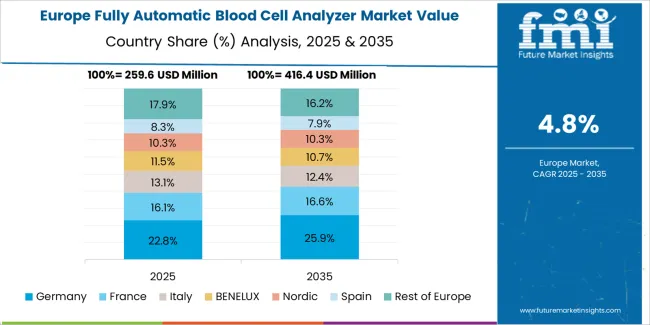
The Fully Automatic Blood Cell Analyzer market in Europe is projected to grow substantially over the forecast period, with Germany expected to maintain its leadership position with a significant market share supported by its advanced healthcare infrastructure and major hospital laboratory centers in Frankfurt and Munich. The United Kingdom follows with strong market presence, driven by comprehensive NHS modernization programs and clinical diagnostic initiatives. France holds substantial market share through specialized hospital laboratory activities, diagnostic testing applications, and clinical research centers.
Italy commands notable market presence through strong hospital modernization and healthcare quality projects. Spain accounts for growing market share aided by healthcare expansion and diagnostic laboratory adoption. The Netherlands maintains steady share driven by specialty healthcare applications and quality diagnostic demand. The Rest of Europe region is anticipated to show steady adoption, reflecting consistent growth in Nordic countries, healthcare expansion in Central European markets, and laboratory modernization upgrades across Eastern European hospital facilities.
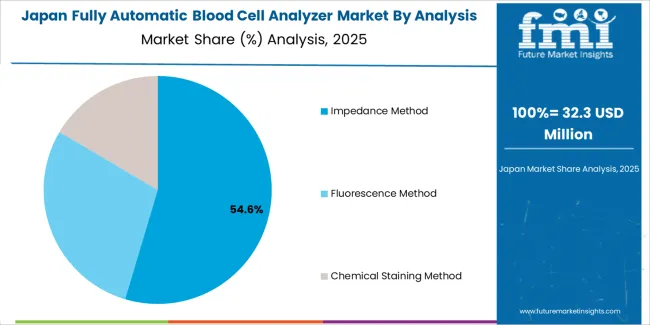
In Japan, the Fully Automatic Blood Cell Analyzer market prioritizes impedance method systems, which capture the dominant share of hospital laboratory and clinical diagnostic installations due to their proven features, including reliable measurement accuracy optimization and seamless integration with existing healthcare infrastructure. Japanese hospital laboratories emphasize reliability, precision, and long-term operational excellence, creating demand for impedance method systems that provide consistent diagnostic capabilities and superior analytical performance based on testing requirements and quality standards. Fluorescence method maintains secondary positions primarily in research laboratory applications and specialized diagnostic testing installations where advanced analytical functionality meets operational requirements without compromising testing precision.
Market Characteristics:
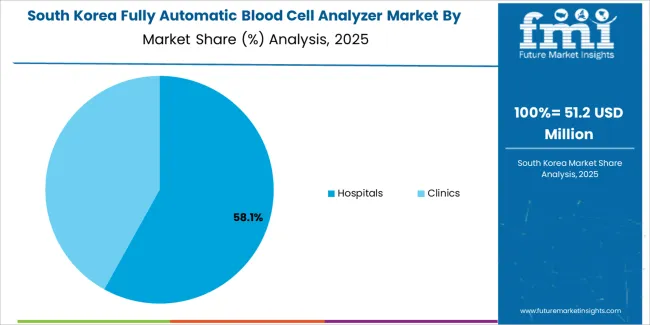
In South Korea, the market structure favors international diagnostic manufacturers, including Beckman Coulter, Sysmex Corporation, and Horiba, which maintain dominant positions through comprehensive product portfolios and established healthcare networks supporting both hospital laboratory testing and clinical diagnostic installations. These providers offer integrated solutions combining advanced analyzer systems with professional technical services and ongoing maintenance support that appeal to Korean hospitals seeking reliable diagnostic systems. Local healthcare distributors and service providers capture moderate market share by providing localized service capabilities and competitive pricing for standard laboratory installations, while domestic manufacturers focus on specialized applications and cost-effective solutions tailored to Korean healthcare market characteristics.
Channel Insights:
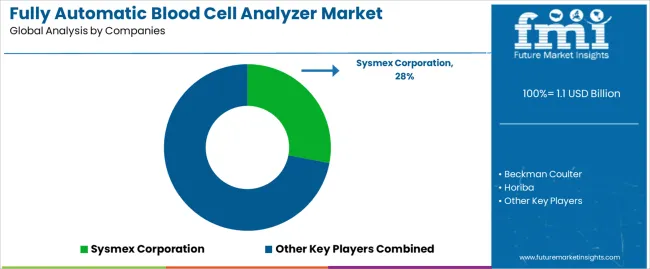
The fully automatic blood cell analyzer market operates with moderate concentration, featuring approximately 15-18 meaningful participants, where leading companies control roughly 55-60% of the global market share through established healthcare relationships and comprehensive diagnostic analyzer portfolios. Competition emphasizes advanced analytical capabilities, diagnostic reliability, and laboratory integration rather than price-based rivalry. The leading company, Sysmex Corporation, commands approximately 28% market share through its extensive hematology analyzer product line and global healthcare presence.
Market Leaders encompass Sysmex Corporation, Beckman Coulter, and Horiba, which maintain competitive advantages through extensive diagnostic technology expertise, global hospital networks, and comprehensive laboratory integration capabilities that create customer loyalty and support premium pricing. These companies leverage decades of hematology analyzer experience and ongoing innovation investments to develop advanced diagnostic systems with precision measurement control and automation features. Technology Innovators include Seamaty, Siemens AG, and regional specialists, which compete through specialized analyzer technology focus and innovative diagnostic capabilities that appeal to laboratories seeking advanced testing solutions and workflow optimization.
These companies differentiate through rapid product development cycles and specialized application focus. Regional Specialists feature diagnostic manufacturers focusing on specific geographic markets and specialized applications, including point-of-care systems and integrated laboratory solutions. Market dynamics favor participants that combine reliable analytical performance with advanced automation capabilities, including precision quality control and automatic laboratory information system integration features. Competitive pressure intensifies as traditional laboratory equipment suppliers expand into hematology analyzer systems, while specialized diagnostic companies challenge established players through innovative testing solutions and integrated platforms targeting hospital laboratory and clinical diagnostic segments.
| Item | Value |
|---|---|
| Quantitative Units | USD 1.1 billion |
| Analysis Method | Impedance Method, Fluorescence Method, Chemical Staining Method |
| Application | Hospitals, Clinics |
| Regions Covered | Asia Pacific, Europe, North America, Latin America, Middle East & Africa |
| Countries Covered | China, India, Germany, Brazil, United States, United Kingdom, Japan, and 20+ additional countries |
| Key Companies Profiled | Beckman Coulter, Sysmex Corporation, Horiba, Seamaty, Siemens AG, Bio-Rad, Diatron, Ajanta Export Industries, Erba Group, Boule Medical AB, Balio diagnostics, Bioevopeak, Linear Chemicals, Abbott Laboratories, Shenzhen Goldsite Diagnostics, Shenzhen Mindray, Hebei Contec Medical Systems |
| Additional Attributes | Dollar sales by analysis method and application categories, regional adoption trends across Asia Pacific, Europe, and North America, competitive landscape with diagnostic manufacturers and healthcare suppliers, laboratory preferences for automation and diagnostic accuracy, integration with hospital information platforms and quality monitoring systems, innovations in analytical technologies and testing excellence, and development of automated laboratory solutions with enhanced performance and workflow optimization capabilities. |
The global fully automatic blood cell analyzer market is estimated to be valued at USD 1.1 billion in 2025.
The market size for the fully automatic blood cell analyzer market is projected to reach USD 1.9 billion by 2035.
The fully automatic blood cell analyzer market is expected to grow at a 5.4% CAGR between 2025 and 2035.
The key product types in fully automatic blood cell analyzer market are impedance method, fluorescence method and chemical staining method.
In terms of application, hospitals segment to command 60.0% share in the fully automatic blood cell analyzer market in 2025.






Full Research Suite comprises of:
Market outlook & trends analysis
Interviews & case studies
Strategic recommendations
Vendor profiles & capabilities analysis
5-year forecasts
8 regions and 60+ country-level data splits
Market segment data splits
12 months of continuous data updates
DELIVERED AS:
PDF EXCEL ONLINE
Fully Enclosed Cartons Market Size and Share Forecast Outlook 2025 to 2035
Fully Enclosed 3D Printing Smart Warehouse Market Size and Share Forecast Outlook 2025 to 2035
Fully Integrated Dishwasher Market Size and Share Forecast Outlook 2025 to 2035
Fully Automated Coagulometer Market
Fully Automatic Hydraulic Lifting Column Market Size and Share Forecast Outlook 2025 to 2035
Fully Automatic Silver Sintering System Market Size and Share Forecast Outlook 2025 to 2035
Fully Automatic High Speed Nail Making Machine Market Size and Share Forecast Outlook 2025 to 2035
Fully Automatic Solid-Liquid Purge Trap Market Size and Share Forecast Outlook 2025 to 2035
Fully Automatic Liquid Metal Printing Machines Market Size and Share Forecast Outlook 2025 to 2035
Fully Automatic Wet Chemical Analyzers Market Size and Share Forecast Outlook 2025 to 2035
Automatic Chicken Deboning Machine Market Size and Share Forecast Outlook 2025 to 2035
Automatic Filter Press Solutions Market Size and Share Forecast Outlook 2025 to 2035
Automatic Filter Presses (AFPs) Market Size and Share Forecast Outlook 2025 to 2035
Automatic Riveting Equipment Market Forecast and Outlook 2025 to 2035
Automatic Powder Forming Machine Market Forecast and Outlook 2025 to 2035
Automatic Weigh Price Labeling Machine Market Size and Share Forecast Outlook 2025 to 2035
Automatic Bending Machine Market Size and Share Forecast Outlook 2025 to 2035
Automatic Transmission Market Size and Share Forecast Outlook 2025 to 2035
Automatic Emergency Braking System Market Size and Share Forecast Outlook 2025 to 2035
Automatic Impact Testing Machine Market Size and Share Forecast Outlook 2025 to 2035

Thank you!
You will receive an email from our Business Development Manager. Please be sure to check your SPAM/JUNK folder too.
Chat With
MaRIA